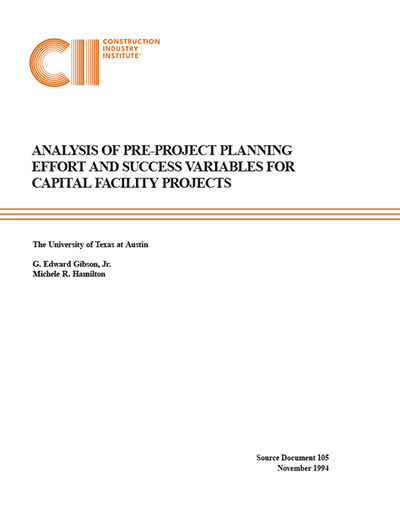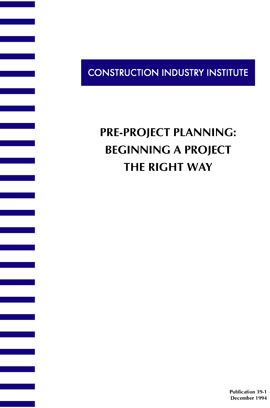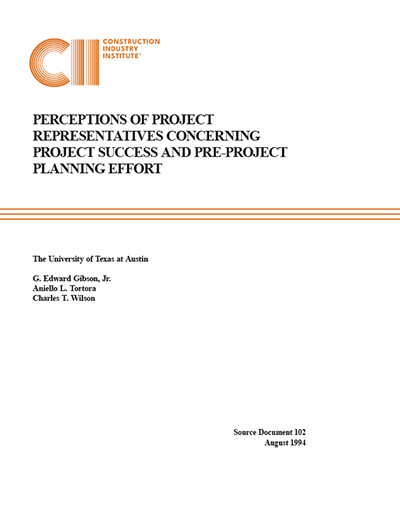
Analysis of Pre-Project Planning Effort and Success Variables for Capital Facility Projects
The CII Pre-Project Planning Research Team was chartered to determine the impact of pre-project planning on the success of projects. The research team conducted a detailed study of capital construction projects to determine how the level of effort expended on pre-project planning affected the success of the projects. This source document presents analysis of quantitative data from 62 projects that were part of that investigation.
The study hypothesis "the successful completion of a capital construction project is positively correlated with the level of effort expended during the pre-project planning phase of the project" was tested using regression analysis. Through index construction and bivariate regression modeling, the relationship between pre-project planning and project success was identified and graphically depicted. This relationship proved to be positive, with a regression equation for the prediction of project success having an R2 of 0.4190.
Six statistically significant pre-project planning variables that lead to success were identified:
- Existence of a Written Project Charter
- Existence of a Pre-Project Planning Plan
- Percent Design Complete at Authorization
- Development of Control Guidelines
- Number of Corporate Groups Represented during Pre-Project Planning
- Defined Execution Approach
Four variables were identified as significant in measuring success:
- Budget Achievement
- Schedule Achievement
- Design Capacity
- Plant Utilization
The major conclusion that can be drawn from this study is that there does exist a positive, quantifiable relationship between effort expended during the pre-project planning phase and the ultimate success of a project. Given the lack of previous research in this area, these findings are significant to the construction industry. This positive relationship was based on analysis of pre-project planning functions identified in the model found in CII Source Document 94. Therefore, this analysis contributes to the verification of the published model.
The pre-project planning effort level directly affects the cost and schedule predictability of the project. By establishing lower third, middle third and upper third pre-project planning effort groups within the sample and evaluating each against success variables, some broad conclusions can be made. As the level of pre-project planning moves from the lower third to the upper third group, average project cost performance versus authorization estimate favorably decreases by as much as 20 percent. Similarly, variance between average schedule performance versus authorization estimate decreases by as much as 39 percent. In addition, plant design capacity attained and facility utilization improve by about 15 percent versus authorization estimate. Finally, project scope changes after authorization tend to decrease as the level of pre-project planning effort increases.
For this sample, the likelihood that a project met or exceeded its financial goals increased as the level of effort in pre-project planning increases. This finding is particularly important because business success is the major criteria used to approve most capital expenditures. Other findings are also outlined in this source document. Many recommendations can be made from the findings of this study.
They fall into two basic categories: 1) organizing for pre-project planning; and 2) having a well defined project scope (project definition plan). Recommendations include:
- The pre-project planning team should be working with a written charter.
- The pre-project planning effort should have a pre-project planning process and plan.
- Participation of more corporate groups with varied interests during the pre-project planning phase increases success.
- Control guidelines should be developed during the pre-project planning process.
- An execution approach for engineering, procurement, construction, and start-up should be developed during the pre-project planning process.
- Design work hours complete before project authorization should be from 10 to 25 percent of total design effort depending on the complexity of the project. Expenditure of less effort should be accompanied with an understanding of the implications.
In summary, facility owners should place emphasis on organizing pre-project planning efforts using a formal process incorporating the effort variables identified in this report. It is also important that they expend the resources necessary to insure a well-defined project scope before an authorization decision is made. Owners should understand that the implication of not providing this effort is decreasing probability of project success.
Contractors are currently providing pre-project planning services to many owners and are encouraged to adopt the findings of this research investigation as well. They should understand the implications of pre-project planning in terms of project execution and the contracting environment that currently exists in the industry.



